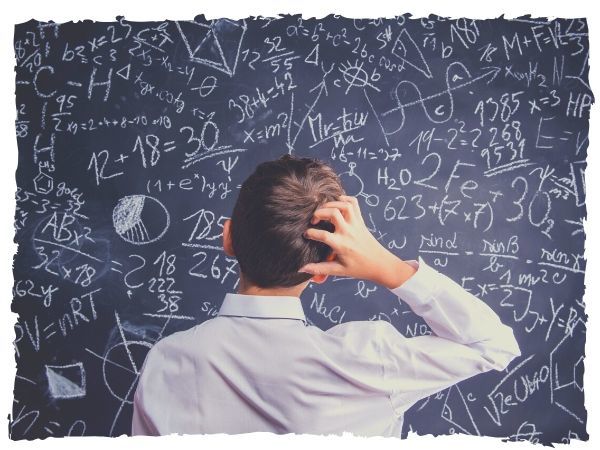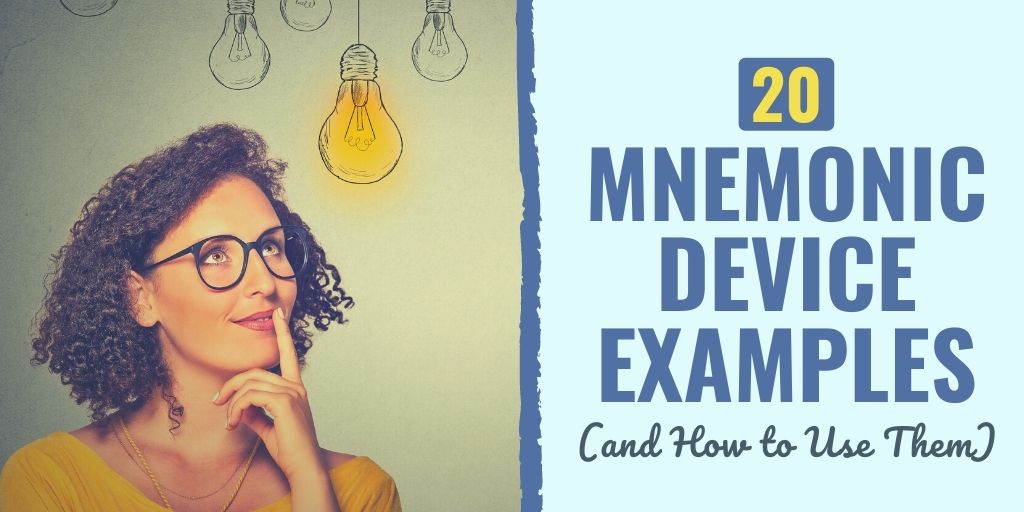There might be affiliate links on this page, which means we get a small commission of anything you buy. As an Amazon Associate we earn from qualifying purchases. Please do your own research before making any online purchase.
Do you ever have something that you have to remember, but for some reason you’re having a hard time keeping it straight in your mind?
For example, one thing that I always have to double check in my mind is how to spell the word “lose”. It sounds like it would have two Os in the middle, because of the “loo” sound. However, I know L-O-O-S-E spells a word with a completely different meaning.
So how do I remember this? I picture the two Os in “loose” made out of two hair rubber bands that are loosely linked together. This creates a visual of the two Os and relates it to the meaning of the word. This is an example of using an image mnemonic.
There are a lot of things that can be extremely helpful to apply a mnemonic device to in order to help you learn and remember it.
While mnemonic techniques have been used for well over 2,000 years, they’ve only been studied experimentally within the last 40 years. The ancient Loci system involves visualizing and memorizing images in a familiar location, such as your office, your house, or anywhere that makes you the most comfortable–then turning each part of that place (the bedrooms, the shelves, chairs) into pieces of information that you’re trying to remember by assigning words or concepts to each zone. This method encourages people to memorize spatial relationships to create a sense of order, therefore making it easier to remember specific information.
In this article, we will look deeper into what a mnemonic device is and the different types of mnemonic devices you can use. We will also look at some examples of these tools to give you a headstart on learning and making up your own mnemonic devices.
But first, let’s look at what a mnemonic device is.
What is a Mnemonic Device?
Mnemonic devices are tools and techniques you can use to help boost your ability to remember, retain, or retrieve information quickly. This memory technique allows your brain to encode important information in a unique way that helps you learn it. This simple shortcut creates an association between the information that you’re trying to remember with a visual picture, a unique sentence, or a single word.
Even if you haven’t heard of the term, you probably already use mnemonics in your life. Many of these techniques are common, taught in school, or used in everyday language.
You’ve probably seen mnemonics used for groups of items and in auditory format, but mnemonics are also used in visual or tactile forms. The basis of their use is that the human mind can quickly recall relatable information, such as personal, surprising, spatial, humorous, etc., while it is more challenging to remember abstract or impersonal bits of information.
Let’s look at the different types of mnemonic devices and some examples of how you can use each one of them.
Imagery Mnemonics
Think about how much easier it is to remember an image than it is to remember words. In fact, research shows that our memories are activated by seeing images much more easily than by hearing words. This is why companies use logos–the images of Target, Amazon, and McDonald’s are now ingrained in everyone’s brain.
Imagery mnemonics are often used to memorize items that are somehow related to each other. By visualizing a specific picture, you can easily recall information that you previously associated with that image. Often, the more ridiculous the image is, the easier it will be for you to remember.
When creating a mnemonic, make your images as distinct and strong as possible. Try to add motion so the interaction between what you’re trying to remember and the image you’re associating it with is more like a movie than a still frame. The more detail you can see and the more activity you can include, the more effective your mnemonic will be.
Imagery mnemonic devices are best used with small bits of information, such as someone’s name or how to pronounce a word. Coming up with your own images is often more helpful than using suggestions from other people. This is because you have your own unique experiences and associations to connect abstract ideas to certain images. However, let’s look at some examples so you get the idea:
1. Remembering People’s Names
Using imagery is an effective way to ensure you won’t experience that heart-stopping moment when you have to introduce someone and you can’t recall their name.
For example, if you meet someone named Peggy, visualize her dressed up as a pirate with a peg leg to help you remember her name. Or, upon meeting someone named Leo, visualize a lion. Next time you see him, you’ll recall this image and therefore remember his name.
If you can pick out a distinguishing feature on someone and associate it with an image, that is also helpful. Just be sure to pick something that you’ll notice again next time you see that person, something that catches your attention in a unique way. Make sure the image relates to their name, and then put the two together and you will be able to easily recall their name.
For example, let’s say you meet someone named Brandon. The stressed syllable in “Brandon” is Bran, which you can shorten to ran. If you meet someone named Brandon who is especially physically fit, you can imagine that he ran this morning for exercise. Picturing Brandon running will stick in your brain and you will be able to recall his name in the future.
2. To Recall Facts
No matter what your profession is, there are probably facts that you need to remember on a regular basis. For instance, if you’re in the medical field, you can remember the depressant drugs: barbiturates, alcohol, and tranquilizers (BAT), by visualizing a bat who has taken all three of these drugs and is wobbling around about to pass out.
Or, if you’re having symptoms that are involved with both the flu and a cold, such as sore throat, cough, and stuffy nose, and you’re trying to figure out the severity of your sickness, try using this mnemonic: To identify that you have the flu, know the FACTS: fever, aches, chills, tiredness, and sudden onset. This can help you determine the difference.
3. Spelling
To remember how to spell “necessary”, visualize a t-shirt. A shirt has one collar and two sleeves, just like this difficult-to-spell word has one C and two Ss. Or to remember the difference between principle and principal, visualize the word “pal” at the end of principal and remember that the principal of your school is your pal.
Acronyms and Acrostics
You’ve probably heard the acronym “Roy G. Biv” be used to list the colors of the rainbow. This is a popular example of a mnemonic device. An acronym is simply an abbreviation that is put together by the first letters of other words and then pronounced as its own word.
An acrostic is a memorization tool that takes the initial letter of every item you want to remember to create a memorable sentence. For example, if you’re trying to remember how to spell “arithmetic”, think of the sentence, “A rat in the house may eat the ice cream.” Put the first letter of every word of this sentence together to spell arithmetic.
You’re probably familiar with more of these than you realize. Here are some commonly used acronym and acrostic mnemonic devices:
4. Order of Operations

To remember the order of operations in algebra, just think about the sentence, “Please excuse my dear aunt Sally.” The first letter of every word in this sentence corresponds with the order of operations: Parentheses, Exponents, Multiplication, Division, Addition, Subtraction.
5. The Great Lakes
Use the acronym HOMES to recall all five of the Great Lakes: Huron, Ontario, Michigan, Erie, and Superior.
6. Music Notes
If you’ve ever studied music, you know that you have to remember the order of notes so you can identify and play the right note at the right time. The treble notes are: EGBDF, which is commonly memorized as, “Every good boy does fine.” The bass notes are ACEG, which is often referred to as, “All cows eat grass.”
7. The Old Testament
One way to memorize the first five books of The Old Testament is to remember this sentence: “God equals light, not darkness.” This will help you recall: Genesis, Exodus, Leviticus, Numbers, Deuteronomy.
8. Compass Directions
You’ve probably heard people say “Never eat shredded wheat” when referring to North, East, South, and West.
9. Geometry
Do you recognize the term, “soh cah toa”? I remember reciting this to myself repeatedly throughout 10th grade when I was taking geometry. Soh cah toa is a mnemonic device to help remember the formulas for sin, cosine, and tan.
10. Parts of Speech
Think of the word “raven” when trying to figure out if you need to use “affect” or “effect”. If you follow the letters in the word raven, you get: Remember, Affect is a Verb and Effect is a Noun.
11. Coordinating Conjunctions
I’m sure you remember hearing the term “FANBOYS” from back in your grade school days. This acronym stands for the coordinating conjunctions, which are: for, and, nor, but, or, yet, so.
Rhymes
Rhyming is another common way to memorize information. Rhymes are easily recalled because they’re stored in your brain through acoustic encoding, which means you’ve learned the information through your auditory senses. This explains why song lyrics are so much easier to memorize than a paragraph out of a book or some other form of prose. Here are some helpful rhyming mnemonics that people often use:
11. Historical Dates
You’ll remember this one from grade school: “In fourteen hundred and ninety-two, Columbus sailed the ocean blue.”
12. Number of Days in the Month
A quick rhyme to remember how many days are in the month goes like this: “Thirty days has September, April, June, and November. All the rest have 31…fine! February has 28 except for when it has 29.”
13. Spelling Rules
Mnemonics are used to remember how to spell words pretty often. But to remember a spelling rule that applies to a lot of words, think of this rhyme: “I before e except after c, or when sounding like a, as in neighbor and weigh.”
Chunking and Organizing
Chunking is a technique that breaks information down into small pieces that are easier to remember. Our brains can only hold about seven pieces of information at once, so using chunking mnemonics helps to simplify complex details.
Organizing is similar to chunking because it involves grouping things together. You can use objective organization by grouping items together in a logical way, or you can use subjective organization by grouping seemingly unrelated things together.
Consider these examples:
14. Long Numbers
Phone numbers, credit card numbers, and social security numbers are all broken up into sections rather than being written as one long stream of digits. Having these important numbers broken down into smaller sets of three or four numbers caters to the needs of our short-term memory.
Which is easier to remember, 8675309 or 867-5309? Or, for a social security number, 446732961 or 446-73-2961?
15. Lists
If you’re trying to memorize a list of things, group similar items together. For example, if you’re trying to remember what you need to buy at the grocery store, break it down into groups. What vegetables do you need, pantry items, frozen foods, and so on. Or, break it down into areas of the grocery store or what shelves that you know then items are on.
16. Long Words
When you learned how to spell Mississippi, you probably learned it in chunks and recited it with a sort of rhythm: M-i-s-s-I-s-s-I-p-p-I. And if you’re like me, you use that trick to this day because it’s so embedded in your brain.
17. Group Items Together by Color
If you use color coding techniques to help you organize your work or remember things, you’re using objective organization.
18. Find Connections
An example of subjective organization is relating going on a cruise to getting on a plane. While these two things have distinct differences, you can also find a connection between the two since they’re both forms of transportation.
You can also use a subjective organization mnemonic when remembering how to set the table. The fork is placed to the left of the plate, and the knife and spoon are placed on the right. The words “fork” and “left” both have four letters, so those are grouped together. And, there are five letters in “knife”, “spoon”, and “right”, which can help you group those together as well.
Models
Using models such as diagrams, flowcharts, and graphs is also a form of a mnemonic. These are visual representations that help you learn and remember a concept. For example, I’m sure you can picture in your mind:

19. The Cell Cycle
The cell cycle includes growth, DNA synthesis, growth and preparation for mitosis, and mitosis. You probably learned this in school by looking at a visual representation of this cycle to help you remember it.
20. Pyramid
If you’re trying to remember information that is ranked in some way, you can write each point moving up the pyramid until you get to the most important item. Doing this can help you remember the specific order that a process needs to go in and the things that must be done in order to move up to the next step.
For example, have you seen Maslow’s Hierarchy of Needs? In the world of psychology, this hierarchical pyramid shows a five-tier model of human needs. The bottom consists of our basic needs of food, water, and shelter. From there, it moves up to safety, love and belonging, esteem, and finally, self-actualization. You can’t get to the top of the pyramid until fulfilling all items below it.
Final Thoughts on Mnemonic Device Examples
If you hadn’t already before, you’ve probably now realized how often you use mnemonics in your life. If you’re trying to improve your memory or looking for tricks to memorize things in an instant, mnemonic devices are great tools to use.
Make your mnemonic devices unique to you so you can more easily remember them. Relate things to something going on in your life or a close friend or family member.
Also, if you need a mnemonic to spell mnemonic, as many people do, remember this sentence: “Memorization's Not Easy; Memory Often Needs Initial Cues.”
Finally, if you want to take your goal-setting efforts to the next level, check out this FREE printable worksheet and a step-by-step process that will help you set effective SMART goals.

Connie Stemmle is a professional editor, freelance writer and ghostwriter. She holds a BS in Marketing and a Master’s Degree in Social Work. When she is not writing, Connie is either spending time with her 4-year-old daughter, running, or making efforts in her community to promote social justice.


